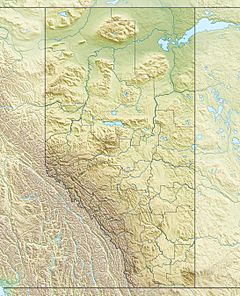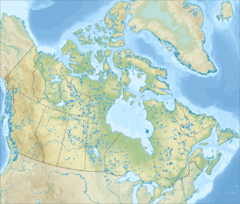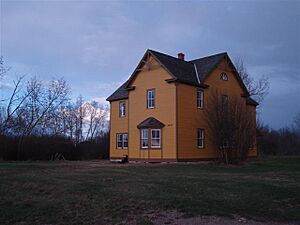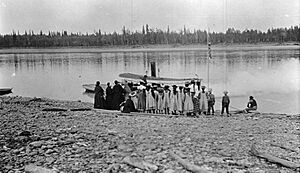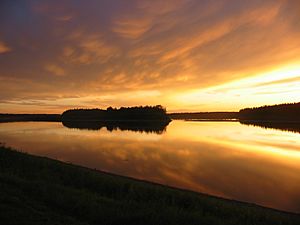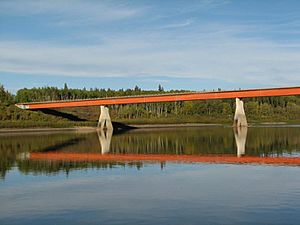Fort Vermilion facts for kids
Quick facts for kids
Fort Vermilion
|
||
|---|---|---|
|
Hamlet
|
||

Aerial view from north
|
||
|
||
| Country | Canada | |
| Province | Alberta | |
| Region | Northern Alberta | |
| Census division | 17 | |
| Specialized municipality | Mackenzie County | |
| Established | 1788 (oldest in Alberta) | |
| Government | ||
| • Type | Unincorporated | |
| Area
(2021)
|
||
| • Land | 5.36 km2 (2.07 sq mi) | |
| Elevation | 270 m (890 ft) | |
| Population
(2021)
|
||
| • Total | 753 | |
| • Density | 140.4/km2 (364/sq mi) | |
| Time zone | UTC−07:00 (MST) | |
| • Summer (DST) | UTC−06:00 (MDT) | |
| Postal code |
T0H 1N0
|
|
| Area code(s) | 780, 587, 825 | |
| Highways | Highway 88 (Bicentennial Highway) | |
| Waterways | Peace River | |
Fort Vermilion is a small community, called a hamlet, located by the Peace River in northern Alberta, Canada. It's part of Mackenzie County.
It was founded in 1788, making it one of the oldest European settlements in Alberta, just like Fort Chipewyan. Fort Vermilion has many modern services for its residents and the nearby rural areas. The main office for Mackenzie County, which is Alberta's largest county by land size, is also found here.
The hamlet is located in Census Division No. 17.
Contents
Fort Vermilion's History
Long before Europeans arrived, the area was home to Indigenous peoples. These included the Dunneza (Beaver), Dene, and later the Cree nations.
Fort Vermilion got its name from the red, vermilion-coloured clays along the riverbanks. It started as a trading post for the North West Company in 1788. This was after Alexander MacKenzie explored the area. The fort was built upstream from the Vermilion Chutes, which were impossible to pass by boat.
During winter, people living at the fort would trade furs with Indigenous trappers. In the summer, these furs were sent by river to trading points further east, eventually reaching Montreal. In 1821, the fort was taken over by the Hudson's Bay Company after a merger. By 1830, it was a very busy fur trading post. The first Anglican church was built here in 1877.
For a long time, the main way to reach Fort Vermilion was by river. People used river boats and ferries to bring supplies during the summer when the water wasn't frozen. In 1903, the first steam-powered boat, the St. Charles, began serving Fort Vermilion. It traveled the 526 kilometres (327 mi) of the Peace River from Hudson's Hope. In 1974, a bridge was built over the Peace River, just west of Fort Vermilion. This bridge finally connected the community to the outside world during winter.
Historic Buildings in Fort Vermilion
The original Old Bay House, where the chief factor (manager) lived, is still standing. It is now part of the Fort Vermilion National Historic Site. It was recognized in 1968 for its importance to the North West Company and Hudson's Bay Company.
The visitor centre is located in a dovetailed log house built in 1923. It was originally on the banks of the Peace River but was moved in 1983. Another historic building is the Clark House, built in 1907 for Hudson's Bay Company clerks. It was moved in 1994 to its current spot near the visitor centre. The Trappers Shack, built in 1912, is another dovetailed log house. It is listed as a provincial historic site.
Fort Vermilion's Population
| Population history of Fort Vermilion |
||
|---|---|---|
| Year | Pop. | ±% |
| 1941 | 292 | — |
| 1951 | 1,413 | +383.9% |
| 1956 | 631 | −55.3% |
| 1961 | 768 | +21.7% |
| 1966 | 971 | +26.4% |
| 1971 | 740 | −23.8% |
| 1976 | 729 | −1.5% |
| 1981 | 752 | +3.2% |
| 1986 | 823 | +9.4% |
| 1991 | 782 | −5.0% |
| 1996 | 775 | −0.9% |
| 2001 | 818 | +5.5% |
| 2006 | 714 | −12.7% |
| 2011 | 727 | +1.8% |
| 2016 | 639 | −12.1% |
| 2021 | 753 | +17.8% |
| Source: Statistics Canada |
||
In 2021, the population of Fort Vermilion was 753 people. They lived in 257 homes. This was an increase from 639 people in 2016. The hamlet covers an area of 5.36 km2 (2.07 sq mi). This means there were about 140 people per square kilometer in 2021.
A local count in 2018 by Mackenzie County showed the population of Fort Vermilion was 763.
Education in Fort Vermilion
Two schools serve Fort Vermilion. Both are managed by the Fort Vermilion School Division No. 52.
Fort Vermilion Public School is part of the public school system. It teaches students from grade 6 to grade 12. About 150 students attend this school. St. Mary's Elementary is a Catholic school. It teaches students from kindergarten to grade 6, with about 145 students.
Northern Lakes College, founded in 1999, has one of its 26 campuses in Fort Vermilion. It used to be called Alberta Vocational Centre Grouard. It offered education to Indigenous students.
Fort Vermilion's Geography
Fort Vermilion is about 77 kilometres (48 mi) southeast of High Level. It is also about 661 kilometres (411 mi) northwest of Edmonton. You can reach it by Highway 88 (Bicentennial Highway). The hamlet of La Crete is about 40 km (25 mi) southwest of Fort Vermilion on Highway 697.
This hamlet is one of the northernmost communities in the Peace River Country. The Peace Country is known for its aspen parkland biome. It is Canada's most northern land suitable for farming. The landscape has many aspen, poplars, and spruce trees. You can also find areas of grasslands. Many animals live here, including bears, moose, deer, beavers, foxes, coyotes, and Canada geese.
Fort Vermilion is located on the southern banks of the Peace River. Its elevation ranges from 255 m (837 ft) to 282 m (925 ft). The North Vermilion Settlement is on the opposite (northern) side of the river. The Fort Vermilion Airport is about 6 km (3.7 mi) downstream.
Fort Vermilion's Infrastructure and Activities
The Fort Vermilion Community and Cultural Complex is a great place for activities. It has a hockey rink, a community hall with a stage and kitchen, and a curling rink. The Fort Vermilion Heritage Centre looks after 25 historic sites. These include old log houses, the Dominion Experimental Farm, and exhibits about Indigenous peoples and nature. The complex also has a place to dump RV waste and refill water. You can find workout facilities, a splash park, ball fields, and a playground here. It's a perfect spot to relax in summer.
St. Theresa General Hospital was built in 1983. It has 26 beds for short-term care and 8 beds for long-term care. It also has an emergency department. About 76 health workers are employed here. The hospital is managed by Alberta Health Services. The Provincial Court of Alberta holds court sessions in Fort Vermilion. The court used to be in the old hospital building. Now it is in a modern building next to St. Henry's Roman Catholic Church. The old hospital building is now used as an office for the Mackenzie Applied Research Association.
The Fantasy North Golf & Country Club is a 9-hole golf course with a long history. It also has mini golf, a driving range, and a clubhouse. However, the course closed in spring 2020 due to flooding from the Peace River. It is still closed because of damage.
The hamlet also has a public library and four churches. These are St. Theresa Catholic Church, Church of God in Christ Mennonite, Faith Gospel Fellowship, and St. Luke's Anglican Church. The St. Luke's Anglican Church Cemetery dates back to 1877.
East of the community is the Fort Vermilion (Wop May Memorial) Aerodrome (TC LID: CEZ4). This airport is managed by Mackenzie County. It provides provincial air ambulance services and helps with aerial firefighting. CanWest Air has a base here for charter and medevac flights. There is also a small heliport called Fort Vermilion/Country Gardens B&B Heliport.
The Rodeo Grounds are about 5 km (3.1 mi) southwest of the community. They host a rodeo every July. The event features cattle roping and bucking broncos, along with other competitions.
Other events and festivals in Fort Vermilion include Canada Day celebrations, the Town and Country Fair, River Daze, and an Arts and Crafts Show. A Farmer's Market is held sometimes. The yearly "Get to Know You Night" in mid-September is popular. It helps residents learn about local services and organizations.
DA Thomas Park is a grassy area for day use in Fort Vermilion. It has picnic tables and campfire spots overlooking the river. There's also a boat launch and dock to access the river.
Several beaches along the Peace River can only be reached by boat. In North Vermilion (Buttertown), there is a beach that you can reach by road.
Famous People from Fort Vermilion
- Fred Brick was an early businessman, farmer, and trader in Fort Vermilion. His wife, Sarah Lendrum, joined him there in 1896.
- Kenton Randle, known as "Rugged," was a cowboy from Fort Vermilion. Born in 1960, he passed away in 2003. Kenton was a bareback bronc rider who represented Canada at the 2002 Olympics in Salt Lake City. In 2015, he was added to the Canadian Pro Rodeo Hall of Fame as a Legend of Rodeo.
- The writers and brothers Will Ferguson and Ian Ferguson grew up in Fort Vermilion. Will describes his childhood there in his book Beauty Tips from Moose Jaw. He mentions that the town was even included in the 1976 version of Ghost Towns of Alberta, which residents didn't like!
- Dave Hancock, who became the 15th premier of Alberta in 2014, grew up in Fort Vermilion.
- Gloria Chomiak Atamanenko, a social worker, writer, and translator, was born in Fort Vermilion.



